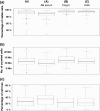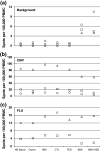Serum-free freezing media support high cell quality and excellent ELISPOT assay performance across a wide variety of different assay protocols
- PMID: 23138872
- PMCID: PMC3624011
- DOI: 10.1007/s00262-012-1359-5
Serum-free freezing media support high cell quality and excellent ELISPOT assay performance across a wide variety of different assay protocols
Abstract
Robust and sensitive ELISPOT protocols are commonly applied concomitant with the development of new immunotherapeutics. Despite the knowledge that individual serum batches differ in their composition and may change properties over time, serum is still commonly used in immunologic assays. Commercially available serum batches are expensive, limited in quantity and need to be pretested for suitability in immunologic assays, which is a laborious process. The aim of this study was to test whether serum-free freezing media can lead to high cell viability and favorable performance across multiple ELISPOT assay protocols. Thirty-one laboratories from ten countries participated in a proficiency panel organized by the Cancer Immunotherapy Immunoguiding Program to test the influence of different freezing media on cell quality and immunologic function. Each center received peripheral blood mononuclear cells which were frozen in three different media. The participants were asked to quantify antigen-specific CD8+ T-cell responses against model antigens using their locally established IFN-gamma ELISPOT protocols. Self-made and commercially available serum-free freezing media led to higher cell viability and similar cell recovery after thawing and resting compared to freezing media supplemented with human serum. Furthermore, the test performance as determined by (1) background spot production, (2) replicate variation, (3) frequency of detected antigen-specific spots and (4) response detection rate was similar for serum and serum-free conditions. We conclude that defined and accessible serum-free freezing media should be recommended for freezing cells stored for subsequent ELISPOT analysis.
Conflict of interest statement
The authors declare that they have no conflict of interest.
Figures




Similar articles
-
Serum is not required for ex vivo IFN-gamma ELISPOT: a collaborative study of different protocols from the European CIMT Immunoguiding Program.Cancer Immunol Immunother. 2010 Apr;59(4):619-27. doi: 10.1007/s00262-009-0814-4. Epub 2010 Jan 6. Cancer Immunol Immunother. 2010. PMID: 20052465 Free PMC article.
-
Performance of serum-supplemented and serum-free media in IFNgamma Elispot Assays for human T cells.Cancer Immunol Immunother. 2010 Apr;59(4):609-18. doi: 10.1007/s00262-009-0788-2. Epub 2009 Nov 6. Cancer Immunol Immunother. 2010. PMID: 19894047 Free PMC article.
-
Concordant proficiency in measurement of T-cell immunity in human immunodeficiency virus vaccine clinical trials by peripheral blood mononuclear cell and enzyme-linked immunospot assays in laboratories from three continents.Clin Vaccine Immunol. 2009 Feb;16(2):147-55. doi: 10.1128/CVI.00326-08. Epub 2008 Dec 17. Clin Vaccine Immunol. 2009. PMID: 19091991 Free PMC article.
-
ELISpot for measuring human immune responses to vaccines.Expert Rev Vaccines. 2011 Mar;10(3):299-306. doi: 10.1586/erv.10.169. Expert Rev Vaccines. 2011. PMID: 21434798 Free PMC article. Review.
-
Validation of the performance and suitability of a new class of FBS optimized for use in single-cell functional assays.J Immunol Methods. 2023 Apr;515:113452. doi: 10.1016/j.jim.2023.113452. Epub 2023 Feb 28. J Immunol Methods. 2023. PMID: 36858170 Free PMC article. Review.
Cited by
-
Self-adjuvanted mRNA vaccination in advanced prostate cancer patients: a first-in-man phase I/IIa study.J Immunother Cancer. 2015 Jun 16;3:26. doi: 10.1186/s40425-015-0068-y. eCollection 2015. J Immunother Cancer. 2015. PMID: 26082837 Free PMC article.
-
Booster immunization with a fractional dose of Prevnar 13 affects cell-mediated immune response but not humoral immunity in CD-1 mice.Heliyon. 2021 Jun 16;7(6):e07314. doi: 10.1016/j.heliyon.2021.e07314. eCollection 2021 Jun. Heliyon. 2021. PMID: 34195422 Free PMC article.
-
The effects of storage temperature on PBMC gene expression.BMC Immunol. 2016 Mar 15;17:6. doi: 10.1186/s12865-016-0144-1. BMC Immunol. 2016. PMID: 26979060 Free PMC article.
-
Optimization of Peripheral Blood Mononuclear Cell Processing for Improved Clinical ELISpot Assay Performance.AAPS J. 2023 Sep 28;25(6):93. doi: 10.1208/s12248-023-00861-y. AAPS J. 2023. PMID: 37770755
-
Optimization of a Method to Detect Autoantigen-Specific T-Cell Responses in Type 1 Diabetes.Front Immunol. 2020 Dec 7;11:587469. doi: 10.3389/fimmu.2020.587469. eCollection 2020. Front Immunol. 2020. PMID: 33424839 Free PMC article.
References
-
- Guidance for industry: clinical considerations for therapeutic cancer vaccines (2011). U.S. Department of Health and Human Services, Food and Drug Administration, Center for Biologics Evaluation and Research. http://www.fda.gov/ucm/groups/fdagov-public/@fdagov-bio-gen/documents/do...
-
- Bedognetti D, Balwit JM, Wang E, Disis ML, Britten CM, Delogu LG, Tomei S, Fox BA, Gajewski TF, Marincola FM, Butterfield LH. SITC/iSBTc cancer immunotherapy biomarkers resource document: online resources and useful tools—a compass in the land of biomarker discovery. J Transl Med. 2011;19:155. doi: 10.1186/1479-5876-9-155. - DOI - PMC - PubMed
-
- Welters MJ, Kenter GG, de Vos van Steenwijk PJ, Lowik MJ, Berends-van der Meer DM, Essahsah F, Stynenbosch LF, Vloon AP, Ramwadhdoebe TH, Piersma SJ, van der Hulst JM, Valentijn AR, Fathers LM, Drijfhout JW, Franken KL, Oostendorp J, Fleuren GJ, Melief CJ, van der Burg SH. Success or failure of vaccination for HPV16-positive vulvar lesions correlates with kinetics and phenotype of induced T-cell responses. Proc Natl Acad Sci USA. 2010;107:11895–11899. doi: 10.1073/pnas.1006500107. - DOI - PMC - PubMed
Publication types
MeSH terms
Substances
LinkOut - more resources
Full Text Sources
Research Materials

